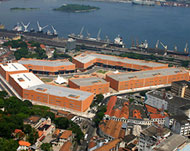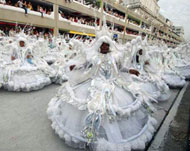The Disneyland of Carnival
For the first time in its history, Rio de Janeiro will play host to a year-long party in a new purpose-built theme-park, Samba City, which has been dubbed the ‘Disneyland of Carnival’.

Rio‘s tourist chiefs are cashing in on the world’s most famous party, which traditionally lasts for five days in February or March, and have created a space to attract visitors throughout the year.
Ailton Guimar?es, the administrator of City of Samba, said: “If we have the demand, we could do shows on other days which would be excellent because we could give work to more people.”
Tourism is booming despite a weak dollar – up by 11 per cent on 2005 – and Rio de Janeiro attracts 1.8 million foreign tourists a year in an industry worth $4 billion annually.
 |
|
Samba City, Rio de Janeiro |
Samba City, which opened its doors in September, also provides a permanent space for the enormous samba ‘schools’ to practice and the president of the city’s samba groups describes it as “the realisation of a dream for half a century”.
Visitors can dress in costume and parade with the samba schools. Each ‘school’, often numbering thousands of participants, has a weekly full rehearsal for six months until their big night during the carnival.
Samba workshops
Six months ahead of the 2007 carnival, work is already in full throttle, with thousands of elaborate costumes being sewn and the enormous floats created.
 |
| Annual parade at the Sambadrome |
But not everyone is happy, complaining that the ‘Disneyland’ is just a commercial proposition that has nothing to do with the spirit of the real thing.
Renato Figueiredo of the Institute of Carnival told Aljazeera: “The presentation for tourists isn’t interesting and not even viable financially, for the public in general. There should be shows with known artists.”
Katia, a Rio resident and samba fan, thinks the whole set up is too touristy and that there is not enought for Rio residents.
She said: “If it continues like this then City of Samba will turn into the Cemetery of Samba.”
African art
The 92,000 square-metre theme-park, which cost $35 million, was constructed in an old industrial district in the exact area where the first samba was played by slaves brought from Africa.
Until 1800, Rio received around 12,000 slaves a year. Between 1800 and 1850 more than a million Africans were brought to the port city. In the 19th century, Rio had the biggest concentration of slaves in the world since the end of the Roman Empire.
In this very spot samba was born, as the slaves played and sang between the docking of cargo ships.
Many samba schools take themes reaching back into their roots. The school of Porto de Pedra, for example, will base its themed dances for Carnival 2007 around the suffering and turmoil of the Apartheid era in South Africa.
Rio is where samba, the music most associated with Carnival, was created and with the construction of a city in its name it is hoped that a future for the ‘schools’ will be secured for generations to come.
Jorge Castanheira, the vice president of Rio’s league of samba schools, said: “The City of Samba project rescues the dignity of the workers of carnival, giving them adequate conditions for their activities.”
Cesar Maia, Rio’s mayor, said: “The City of Samba and the Sambadrome are two spaces that compliment each other. Samba has its theme-park which will be a factory of creation of popular culture, constructed on sacred soil in the neighbourhood where samba carioca was born.”